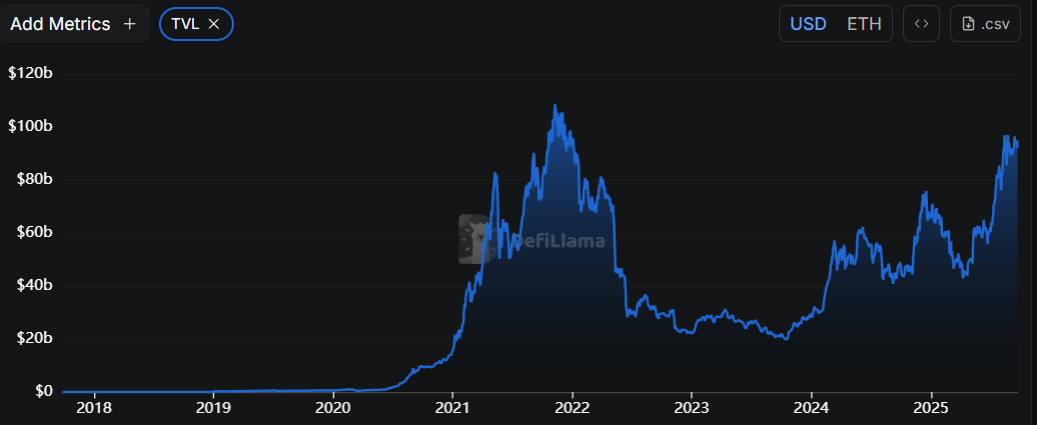TLDR
- Vitalik Buterin proposes low-risk DeFi as Ethereum’s stable revenue source, comparing it to how Google Search funds other Google projects
- Basic DeFi services like stablecoin lending currently offer 5% yields on blue-chip assets, providing steady returns without speculation
- Ethereum’s DeFi ecosystem has recovered with total value locked surpassing $100 billion for the first time since early 2022
- The network faces revenue challenges with on-chain income dropping 44% in August to $14.1 million
- Buterin promotes basket currencies and flatcoins as alternatives to traditional dollar-based financial tools
Ethereum co-founder Vitalik Buterin has presented a strategy where low-risk decentralized finance protocols could serve as the network’s main income generator. He draws parallels to Google Search, which produces consistent ad revenue that supports the company’s wider operations.
In a recent blog post, Buterin stated that Ethereum requires a steady revenue stream that preserves its core principles. The current landscape shows a divide between high-fee speculative products and values-driven applications that face financial difficulties.
Low-risk DeFi protocols present a balanced solution. These encompass basic financial services including payments, savings accounts, and collateralized lending that have stabilized since DeFi’s turbulent early period.
Buterin references Aave’s lending rates as a practical example. Blue-chip stablecoins such as USDT and USDC currently generate approximately 5% returns through these platforms. Riskier assets provide yields above 10%.
The Ethereum founder views these returns as a dependable foundation layer of revenue. Unlike speculative trading or NFT markets, low-risk lending matches the network’s decentralized principles while producing consistent fees.
Buterin contrasts Ethereum’s method with Google’s advertising-based model. While Google offers valuable open-source tools like Chromium, its dependence on ads undermines user privacy.
Ethereum’s decentralized structure could match financial success with ethical results. The network can create revenue without compromising user data or control.
DeFi Market Demonstrates Recovery
Ethereum’s DeFi ecosystem has displayed recent growth. Total value locked across protocols has exceeded $100 billion for the first time since early 2022.

This upturn follows a period where TVL declined during the 2022-2023 bear market. Recent regulatory changes, including the Digital Asset Market Clarity Act, have boosted institutional interest.
A survey from the DeFi Education Fund revealed that over 40% of Americans would consider using DeFi under stronger regulatory frameworks. This indicates potential for mainstream adoption of low-risk protocols.
Despite positive trends, Ethereum confronts current revenue obstacles. On-chain revenue fell 44% in August to $14.1 million, down from $25.6 million in July.
Network fees also declined 20% month-over-month. The Dencun upgrade, which lowered layer-2 transaction costs, has reduced Ethereum’s base-layer revenue long-term.
Some analysts call August’s numbers among the weakest since early 2021. Critics worry that declining fee revenue could threaten ETH’s value proposition.
Future Protocol Development
However, supporters maintain that Ethereum is transforming into a foundational layer for global finance. Lower costs could drive broader adoption of DeFi services.
Buterin also promoted basket currencies and flatcoins as part of this stable foundation. These digital assets link to consumer price indices or multiple fiat currencies rather than single dollar-denominated tools.
The Ethereum co-founder envisions future developments like reputation-based lending and prediction markets. These would build upon the stable base of low-risk protocols.
Ethereum’s DeFi total value locked currently remains above $100 billion, representing its highest level since early 2022.



